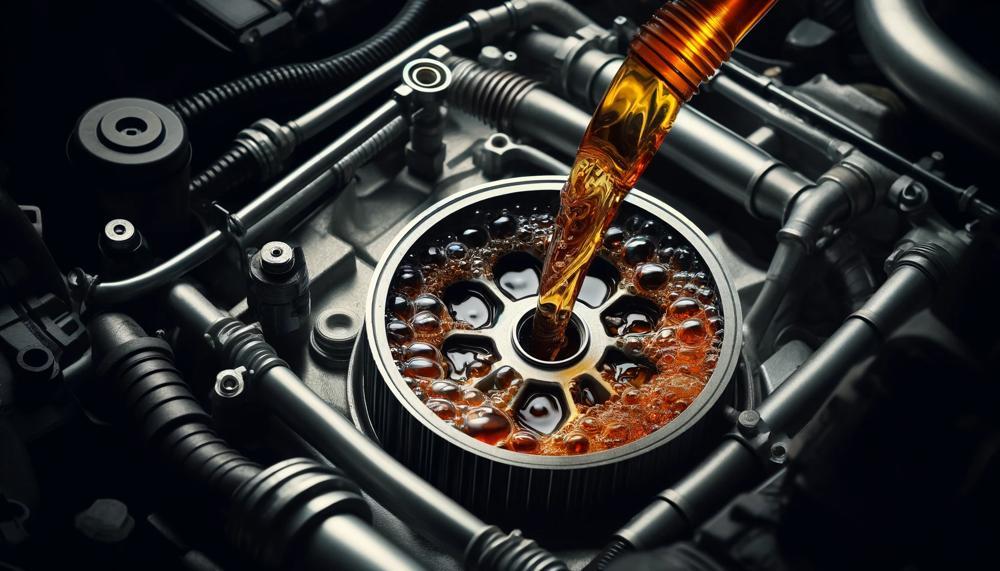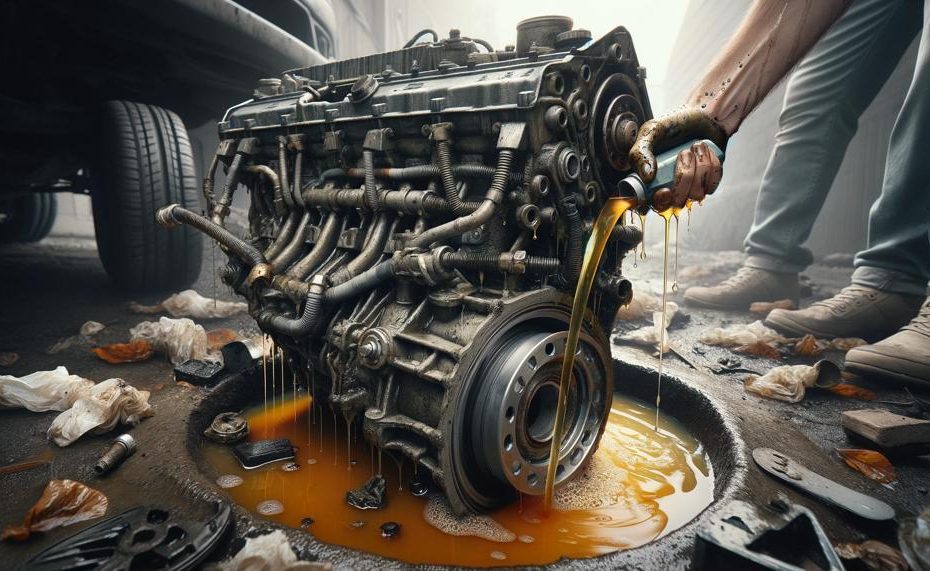While everyone knows how to properly dispose of transmission oil, it is one of the most common things that people forget to do when they are taking care of their cars. It doesn’t matter if you’re a professional mechanic or a do-it-yourselfer on the weekends; you need to be careful with this sensitive topic.
Take a moment to think about how transmission oil got from being an important part of how well your car runs to a possible environmental threat. The difference is very clear, and it shows how important it is for us to close the loop properly.
This blog post will help you find your way through the confusing world of safe dumping. The goal is to make the process less mysterious and give you a sense of duty and knowledge.
So, how to dispose of transmission fluid safely?
Transmission fluid is recyclable, but it should be disposed of safely. Here are some steps you can take:
- Drain the fluid
- Pour the fluid into a clean, leak-proof container
- Seal the container
- Wrap the container in a heavy duty plastic trash bag
- Take the container to a local disposal facility
So, let’s dive in now.
Contents
- 1 How to Dispose of Transmission Fluid Safely
- 2 Understanding Transmission Fluid: How Does it Work?
- 3 How to Work with Transmission Fluid Safely
- 4 Adding the Transmission Fluid into Your Car System
- 5 Why You Should Dispose of Transmission Fluid Correctly
- 6 How to Work with Transmission Fluid Safely
- 7 Adding the Transmission Fluid into Your Car System
How to Dispose of Transmission Fluid Safely
Disposing of transmission fluid in an environmentally-friendly manner is not just good practice; it’s crucial for preserving our planet.
Below are the methods you can use to ensure the safe and responsible disposal of transmission fluid:
| Method | Details | Where to Go |
| Recycling Centers | Take your sealed container of used transmission fluid to a local recycling center that accepts hazardous materials. | Check with your city’s waste management services or online directories for locations near you. |
| Auto-Part Stores | Many auto-part retailers offer free recycling services for automotive fluids. Ensure the fluid is cool and in a leak-proof container. | Popular auto-part chains or local automotive shops. |
| Donation | Auto repair shops, educational institutions with automotive programs, and certain industries may accept used transmission fluid for practical training or other uses. | Contact local auto repair shops, technical schools, or vocational institutions. |
| Community Collection Events | Participate in community hazardous waste collection days, which are often free and accept a variety of materials including transmission fluid. | Local government or environmental agencies usually announce these events. Look for announcements in local newspapers or on community bulletin boards. |
Before you head out to dispose of your transmission fluid, remember these golden rules:
- Cool Down: Always allow the fluid to cool before handling it.
- Seal It Up: Transfer the fluid into a sturdy, leak-proof container and label it clearly as hazardous waste.
- Never Dump: Pouring transmission fluid into the drain, on the ground, or in the trash can harm the environment and water sources. Always opt for responsible disposal methods.
Understanding Transmission Fluid: How Does it Work?
Transmission fluid is a key player in your car’s transmission system, with dual roles in both lubrication and cooling.
| Characteristic | Function | Importance |
| Lubrication | Minimizes friction | Prevents wear and tear |
| Cooling | Controls temperature | Prevents overheating |
| Hydraulic Pressure | Facilitates gear shifts | Ensures smooth operation |
In essence, without this fluid, your car’s transmission would be prone to increased friction, leading to rapid wear and eventual breakdown. The cooling aspect is crucial too, especially in automatic cars where constant gear shifts can generate a lot of heat.
How to Work with Transmission Fluid Safely
When dealing with transmission fluid, it’s crucial to follow safety measures to prevent accidents and ensure proper handling. Here’s a guide:
| Preparation | Ensure the vehicle is on a level surface and the engine is cooled. Wear gloves and safety glasses for protection. |
| Handling | Avoid contact with hot components. Use the right tools and equipment to check and fill transmission fluid. |
| Cleanup | Clean any spills immediately to prevent slips. Store or dispose of used fluid responsibly. |
- Proper Tools and Protective Gear: Don gloves and safety glasses. This avoids direct skin contact and protects your eyes from splashes.
- Check Levels Regularly: Regular monitoring ensures your transmission runs smoothly and identifies leaks early.
- Cool Down First: Never work on a hot transmission. Let your vehicle cool to prevent burns.
- Level Surface for Accuracy: A tilted vehicle can give false readings, leading to incorrect fluid levels.
- Handling Spills: If transmission fluid spills, clean it promptly. It’s slippery and can be a hazard.
- Disposal Considerations: After use, store the fluid in a leak-proof container. Take it to a recycling center or follow local guidelines for disposal.
- Consult Your Manual: Always refer to your vehicle’s manual for specific advice on handling transmission fluid.
- Professional Advice: For complex issues, consult a mechanic. They can offer insights into your vehicle’s specific needs.
Adding the Transmission Fluid into Your Car System

To properly add transmission fluid to your car’s system without causing damage or malfunctions, follow these steps:
Step 1: Warm Up Your Vehicle
Run your car for a few minutes. This ensures the fluid is warm for a precise level check.
Step 2: Locate the Dipstick
Find the transmission fluid dipstick under your hood. In some cars, you may need to open a bolt on the transmission.
Step 3: Check Fluid Level
Use a clean rag to wipe the dipstick, reinsert it, then pull it out again to check the fluid level. It should be between the two hash marks.
Step 4: Prepare for Adding Fluid
If the level is low, prepare to add fluid. Use a funnel that fits the transmission fluid dipstick tube to prevent spills.
Step 5: Add Fluid Gradually
Pour in small amounts of the correct type of transmission fluid. After each pour, recheck the level to ensure you don’t overfill.
Step 6: Recheck Fluid Level
After reaching the optimal level, reinsert the dipstick and close any bolts if opened.
Here’s a table summarizing the key tools and steps:
| Tool/Item | Description | Usage |
| Clean Rag/Paper Towel | To clean the dipstick for an accurate reading | Use before and after checking the fluid level |
| Long Funnel | For adding fluid without spilling | Place in the dipstick tube when adding fluid |
| Correct Transmission Fluid | Specific type recommended for your car | Add gradually, checking the level frequently |
Why You Should Dispose of Transmission Fluid Correctly
Disposing of transmission fluid correctly is not just a matter of keeping your car running smoothly; it’s a crucial step in safeguarding our planet. Here’s why it’s so vital:
Environmental Impact
| Soil Contamination | Transmission fluid contains harmful chemicals and heavy metals that, when leaked into the ground, can drastically reduce soil fertility and harm plant life. |
| Water Pollution | These toxic substances can seep into groundwater or run off into nearby water bodies, posing a significant threat to aquatic life and potentially entering our drinking water supply. |
| Air Pollution | Incorrect disposal methods, such as burning used transmission fluid, release dangerous pollutants into the air, degrading air quality and contributing to respiratory health issues. |
| Ecosystem Disruption | The chemical additives and heavy metals can disrupt the delicate balance of ecosystems, harming wildlife and leading to long-term environmental damage. |
Responsible Disposal
To avoid these dire consequences, it’s imperative to dispose of transmission fluid responsibly.
This can involve taking it to a certified recycling center, collaborating with reputable auto repair shops that follow sustainable practices, or participating in local hazardous waste collection events.
How to Work with Transmission Fluid Safely
Working with transmission fluid safely is key to maintaining both your vehicle’s health and your own.
Here are some pivotal safety precautions and their implementations:
| Safety Precaution | Why It’s Important | How to Implement |
| Personal Protective Gear | Prevents direct contact, avoiding irritation or burns. | Wear nitrile gloves and safety goggles. |
| Proper Ventilation | Reduces risk of inhaling toxic fumes. | Work in well-ventilated areas, preferably outdoors. |
| Correct Disposal | Prevents environmental contamination. | Use certified recycling or disposal services. |
| Use of Correct Fluid Type | Ensures the longevity and proper functioning of the transmission. | Refer to vehicle’s manual for the recommended fluid type. |
| Avoiding Environmental Harm | Minimises the risk of pollution and wildlife harm. | Use absorbent materials for spills; never pour down drains. |
| Temperature Management | Prevents burns from hot fluid. | Let the fluid cool before handling. |
| Safe Storage | Reduces the risk of accidental ingestion or spillage. | Label and store fluids in secure, leak-proof containers. |
Adding the Transmission Fluid into Your Car System
When you’re sprucing up your car’s system with new transmission fluid, it’s not just about the pour-in; it’s equally about handling the old fluid with care. Here’s how to do it right, keeping both the law and our planet in mind.
Safe Disposal of Old Transmission Fluid
Disposing of old transmission fluid isn’t just a toss-it-out task.
It requires thought, respect for the environment, and a touch of savvy to ensure it’s done right.
First up, you’ll need to gear up with gloves and safety goggles to avoid any splashes or spills on your skin. Grab a funnel and a sturdy container to catch every drop of the old fluid as you drain it out.
Locating a Disposal Site
| Option | Details | Why It Matters |
| Automotive Recycling Centers | Facilities that accept used oil, transmission fluid, and other automotive fluids. | These centers ensure fluids are recycled or disposed of safely, keeping them out of waterways and soil. |
| Burn Off (Large Amounts) | Using a metal container to safely burn off large quantities. | Effective for large volumes, but must be done with extreme caution and in permissible areas only. |
| Aluminum Pan (Small Amounts) | Pouring small amounts into a disposable pan to evaporate. | Suitable for minimal quantities, but not the most environmentally friendly method. |
Follow Local Regulations
It’s paramount to check with your local environmental agency or waste disposal authority. They’ll give you the rundown on how and where you can ditch that old fluid without stepping on the wrong side of the law or harming Mother Earth.
No-Nos in Disposal
Let’s make it crystal clear – never, and we mean never, pour transmission fluid down the drain, into the soil, or anywhere it doesn’t belong.
Doing so can contaminate water supplies, harm wildlife, and could land you in a heap of trouble with fines or worse.
Sealing and Labeling
Once you’ve drained the fluid into a suitable container, seal it up tight and slap a label on it.
Make sure it’s marked clearly so there’s no confusion about what’s inside. This step is crucial for safe transportation to the disposal site.
Drop Off
With your old transmission fluid packed and labeled, it’s off to the disposal site you’ve picked out.
Hand it over with a clear conscience, knowing you’ve done your bit for your car and your planet.





